Karnataka State Board Solutions for 2nd PUC Physics Question Banks with Answers, Solutions, Notes, Guide Pdf are prevailing here in direct pdf links for effective exam preparation. Students who are studying for 2nd PUC Physics textbook solutions can refer to this page for grabbing KSEEB 2nd PUC Physics Solutions pdf chapter wise for free. By reading the textbook solutions. You Can Download 2nd PUC Question Bank with Answers from Karnataka State Board solutions, you will be able to understand all the exercises and score good marks.
Also, there are so many advantages that you can avail from the Karnataka State Board Solutions for 2nd PUC Physics Question Bank with Answers, Solutions pdf. So download 2nd PUC Physics Notes from KTBS Solutions Pdf via quick links & access them easily while preparation. Students can also read 2nd PUC physics Model Question Papers with Answers hope will definitely help for your board exams.

Karnataka 2nd PUC Physics Question Bank with Answers
Provided Karnataka State Board solutions for 2nd PUC Physics textbook solutions are prepared by subject experts after ample research. So students are suggested to download the 2nd PUC Physics Question Bank with Answers and Textbook Solutions from the available PDF links and kickstart your preparations for final exams. You can download them freely & practice regularly to score high marks in the examinations. Access the below Chapter-wise links and learn complete by using 2nd PUC Physics Question Bank with Answers from Karnataka State Board solutions pdf.
- Chapter 1 Electric Charges and Fields
- Chapter 2 Electrostatic Potential and Capacitance
- Chapter 3 Current Electricity
- Chapter 4 Moving Charges and Magnetism
- Chapter 5 Magnetism and Matter
- Chapter 6 Electromagnetic Induction
- Chapter 7 Alternating Current
- Chapter 8 Electromagnetic Waves
- Chapter 9 Ray Optics and Optical Instruments
- Chapter 10 Wave Optics
- Chapter 11 Dual Nature of Radiation and Matter
- Chapter 12 Atoms
- Chapter 13 Nuclei
- Chapter 14 Semiconductor Electronics: Materials, Devices and Simple Circuits
- Chapter 15 Communication Systems
Karnataka 2nd PUC Physics Syllabus and Marking Scheme
Karnataka 2nd PUC Physics Blue Print of Model Question Paper
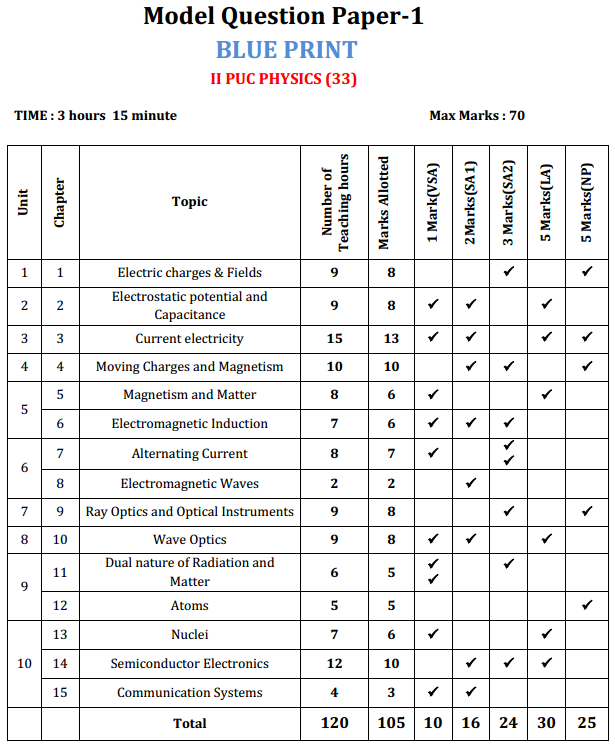
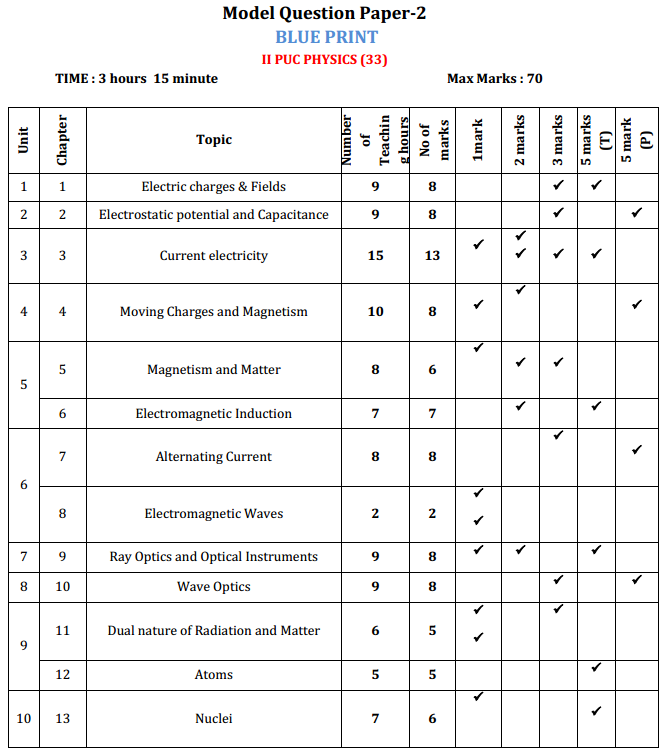

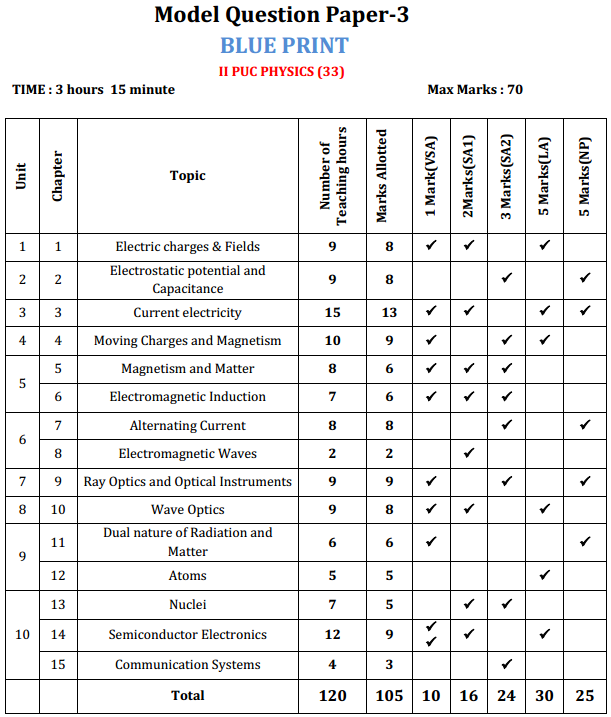
Karnataka 2nd PUC Physics Question Paper Design
Time: 3 Hours 15 Minutes (of which 15 minutes for reading the question paper).
Maximum Marks: 70
The weightage of the distribution of marks over different dimensions of the question paper is as follows:
A. Weightage to Objectives:
| Objective | Weightage | Marks |
| Knowledge | 40% | 43/105 |
| Understanding | 30% | 31/105 |
| Application | 20% | 21/105 |
| Skill | 10% | 10/105 |
B. Weightage to Content/Subject Units:
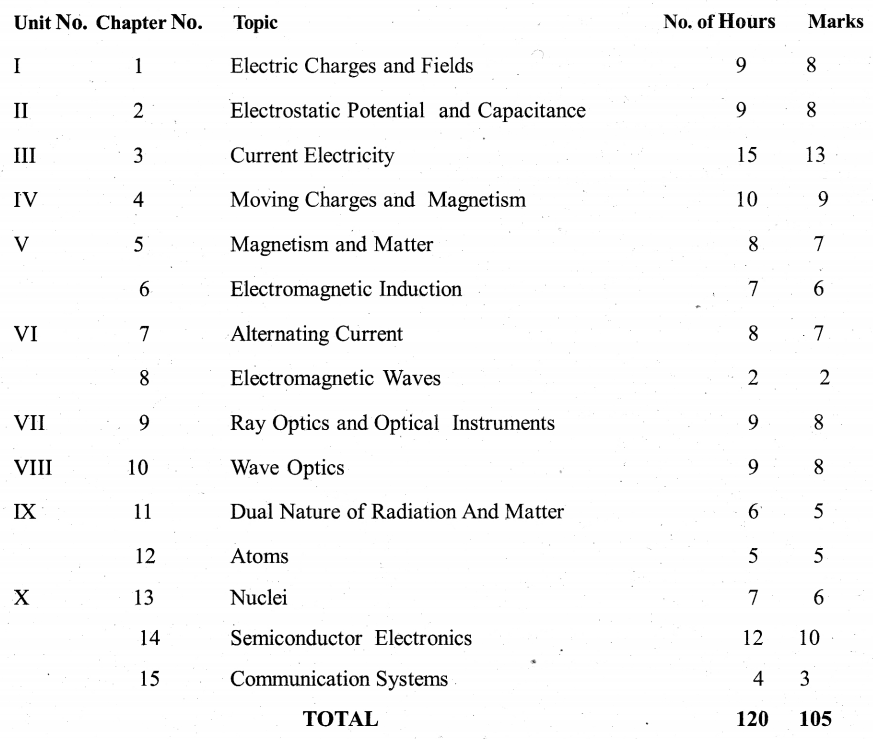
C. Weightage to forms of Questions:
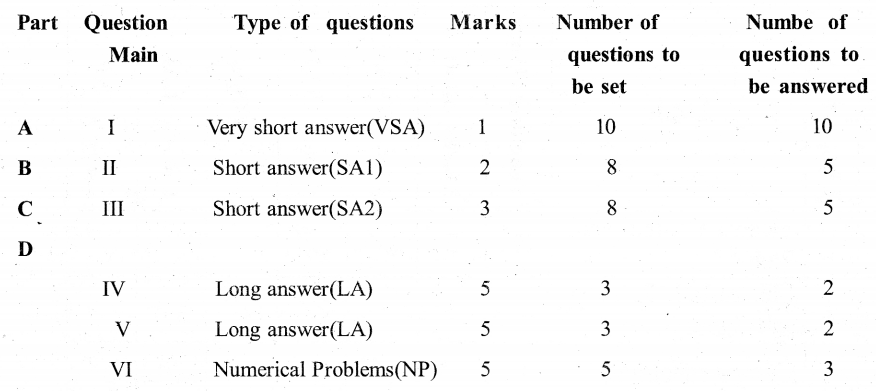
Note:
- Questions in IV Main must be set from Unit I to V.
- Questions in V Main must be set from Unit VI to X.
- Questions in VI Main must be set such that one Numerical Problem is from every 2 successive units.
D. Weightage to the Level of Difficulty:
| Level | Weightage | Marks |
| Easy | 40% | 43/105 |
| Average | 40% | 42/105 |
| Difficult | 20% | 20/105 |
General Instructions
- Questions should be clear, unambiguous, understandable and free from grammatical errors.
- Questions which are based on the same concept, law, fact etc. and which generate the same answer should not be repeated under different forms (VSA, SA, LA and NP).
- Questions must be set based on the blowup syllabus only.
2nd PUC Physics Practical Exam Syllabus
List of Experiments
- To find resistance of a given wire using metre bridge and hence determine the specific resistance of its material.
- To determine resistance per cm of a given wire .by plotting a graph of potential difference versus current.
- To verify the laws of combination (series/ parallel) of resistances using a metre bridge.
- To compare the EMFs of two given primary cells using potentiometer.
- To determine the internal resistance of given primary cell using potentiometer.
- To determine resistance of a galvanometer by half-deflection method and to find its.figure of merit.
- To convert the given galvanometer (of known resistance of figure of merit) into an ammeter and voltmeter of desired range and to verify the same.
- To find the frequency of the ac mains with a sonometer.
- To find the value of v for different values of u in case of a concave mirror and to find the focal ‘ length.
- To find the focal length of a convex mirror, using a convex lens.
- To find the focal length of a convex lens by plotting graphs between u and v or between 1/uand 1/v.
- To find the focal length of a concave lens, using a convex lens.
- To determine angle of minimum deviation for a given prism by plotting a graph between the angle of incidence and the angle of deviation.
- To determine the refractive index of a glass slab using a travelling microscope.
- To find the refractive index of a liquid by using
- Concave mirror
- Convex lens and plane mirror.
- To draw the I-V characteristics curves of a p-n junction in forward bias and reverse bias.
- To draw the characteristics curve of a Zener diode and to determine its reverse break down voltage.
- To study the characteristics of a common- emitter NPN or PNP transistor and to find out the values of current and voltage gains.
2nd PUC Physics Practical Exam Marking Scheme
General Instructions
- Duration of practical examination: 2 hours.
- Maximum marks allotted: 30 marks.
- At least TEN (10) different experiments have to be set in the practical Examination.
Scheme of Evaluation
A. Weightage of Marks
| S.No. | Particulars | Marks |
| I | Performing the Experiment | 20 |
| II | Viva – Voce | 4 |
| III | Practical Record | 6 |
| Total | 30 |
B. Distribution of Marks
I. Performing the Experiment
- Writing the principle of the experiment (2 Marks)
- Writing the formula and explaining the terms (2 Marks)
- Writing the diagram/figure/circuit with labelling (At least two parts) (2 Marks)
- Writing the tabular column/observation pattern (2 Marks)
- Constructing the experimental set up/ circuit (3 Marks)
- Performing the experiment and entering the readings into the tabular column/Observation pattern (4 Marks)
- Substitution and calculation/plotting the graph and calculation (3 Marks)
- Result with a unit (2 Marks)
- Total 20 marks
Note for S.No.6
- At least three (3) trials have to be taken in case of finding mean value.
- At least six (6) readings have to be taken in case of plotting the graph.
II. Viva – Voce
- Four questions must be asked and each question carries 1 mark.
- The questions in the viva- voce should be simple, direct and related to the experiment being performed by the student.
III. Practical Record
- If the student has performed and recorded 13 experiments or more (6 Marks)
(91% to 100% of the experiments prescribed for the practical examination or more) - If the student has performed and recorded 11 or 12 experiments. (5 Marks)
(81% to 90% of the experiments prescribed for the practical examination) - If the student has performed and recorded 10 experiments. (4 Marks)
(71% to 80% of the experiments prescribed for the practical examination) - If the student has performed and recorded below 10 and above 5 experiments. (3 Marks)
(41% to 70% of the experiments prescribed for the practical examination) - If die student has performed and recorded 5 or less than 5 experiments. (0 Marks)
(40% & below 40% Of the experiments prescribed for the practical examination)
We wish the data shed above will benefit you at the time of your preparation & gain good scores. So, download Karnataka State Board 2nd PUC Physics Question Bank with Answers from here and become a topper in the final examinations. Moreover, keep in touch with our site & get all updated chapter wise KSEEB State Board Solutions for all subjects.
